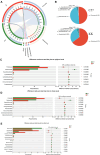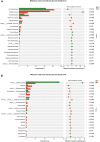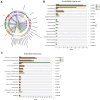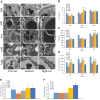Specific Alternation of Gut Microbiota and the Role of Ruminococcus gnavus in the Development of Diabetic Nephropathy
- PMID: 38346799
- PMCID: PMC11016775
- DOI: 10.4014/jmb.2310.10028
Specific Alternation of Gut Microbiota and the Role of Ruminococcus gnavus in the Development of Diabetic Nephropathy
Abstract
In this study, we aim to investigate the precise alterations in the gut microbiota during the onset and advancement of diabetic nephropathy (DN) and examine the impact of Ruminococcus gnavus (R. gnavus) on DN. Eight-week-old male KK-Ay mice were administered antibiotic cocktails for a duration of two weeks, followed by oral administration of R. gnavus for an additional eight weeks. Our study revealed significant changes in the gut microbiota during both the initiation and progression of DN. Specifically, we observed a notable increase in the abundance of Clostridia at the class level, higher levels of Lachnospirales and Oscillospirales at the order level, and a marked decrease in Clostridia_UCG-014 in DN group. Additionally, there was a significant increase in the abundance of Lachnospiraceae, Oscillospiraceae, and Ruminococcaceae at the family level. Moreover, oral administration of R. gnavus effectively aggravated kidney pathology in DN mice, accompanied by elevated levels of urea nitrogen (UN), creatinine (Cr), and urine protein. Furthermore, R. gnavus administration resulted in down-regulation of tight junction proteins such as Claudin-1, Occludin, and ZO-1, as well as increased levels of uremic toxins in urine and serum samples. Additionally, our study demonstrated that orally administered R. gnavus up-regulated the expression of inflammatory factors, including nucleotide-binding oligomerization domain-like receptor pyrin domain-containing protein 3 (NLRP3) and Interleukin (IL)-6. These changes indicated the involvement of the gut-kidney axis in DN, and R. gnavus may worsen diabetic nephropathy by affecting uremic toxin levels and promoting inflammation in DN.
Keywords: Gut microbiota; Ruminococcus gnavus; diabetic nephropathy; inflammation; uremic toxins.
Conflict of interest statement
The authors have no financial conflicts of interest to declare.
Figures









Similar articles
-
Gut microbiota dynamics in KK-Ay mice: restoration following antibiotic treatment.Folia Microbiol (Praha). 2024 Oct;69(5):1159-1173. doi: 10.1007/s12223-024-01157-0. Epub 2024 Mar 27. Folia Microbiol (Praha). 2024. PMID: 38536641
-
Paecilomyces cicadae-fermented Radix astragali ameliorate diabetic nephropathy in mice by modulating the gut microbiota.J Med Microbiol. 2022 May;71(5). doi: 10.1099/jmm.0.001535. J Med Microbiol. 2022. PMID: 35617337
-
Sanziguben polysaccharides improve diabetic nephropathy in mice by regulating gut microbiota to inhibit the TLR4/NF-κB/NLRP3 signalling pathway.Pharm Biol. 2023 Dec;61(1):427-436. doi: 10.1080/13880209.2023.2174145. Pharm Biol. 2023. PMID: 36772833 Free PMC article.
-
Ruminococcus gnavus: friend or foe for human health.FEMS Microbiol Rev. 2023 Mar 10;47(2):fuad014. doi: 10.1093/femsre/fuad014. FEMS Microbiol Rev. 2023. PMID: 37015876 Free PMC article. Review.
-
Enterorenal crosstalks in diabetic nephropathy and novel therapeutics targeting the gut microbiota.Acta Biochim Biophys Sin (Shanghai). 2022 Oct 25;54(10):1406-1420. doi: 10.3724/abbs.2022140. Acta Biochim Biophys Sin (Shanghai). 2022. PMID: 36239349 Free PMC article. Review.
Cited by
-
Characterization of gut dysbiosis and intestinal barrier dysfunction in patients with metabolic dysfunction-associated steatotic liver disease and chronic kidney disease: a comparative study.Sci Rep. 2025 May 3;15(1):15481. doi: 10.1038/s41598-025-00237-6. Sci Rep. 2025. PMID: 40319096 Free PMC article.
-
Modulating the gut microbiota and inflammation is involved in the effect of diosgenin against diabetic nephropathy in rat.Front Pharmacol. 2025 May 19;16:1555849. doi: 10.3389/fphar.2025.1555849. eCollection 2025. Front Pharmacol. 2025. PMID: 40458807 Free PMC article.
-
Gut Microbiota and Their Metabolites: The Hidden Driver of Diabetic Nephropathy? Unveiling Gut Microbe's Role in DN.J Diabetes. 2025 Apr;17(4):e70068. doi: 10.1111/1753-0407.70068. J Diabetes. 2025. PMID: 40189872 Free PMC article. Review.
-
Gut microbiota and NLRP3 inflammasome activation in hemodialysis patients: exploring the link with systemic inflammation.Mol Biol Rep. 2025 May 19;52(1):465. doi: 10.1007/s11033-025-10562-8. Mol Biol Rep. 2025. PMID: 40387945
-
A bibliometric study of global trends in diabetic nephropathy and intestinal flora research.Front Microbiol. 2025 May 21;16:1577703. doi: 10.3389/fmicb.2025.1577703. eCollection 2025. Front Microbiol. 2025. PMID: 40469726 Free PMC article.

